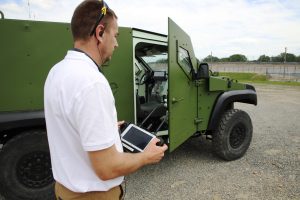
Step by step, towards autonomous vehicles
Leveraging the work done in the commercial world by its mother group Volvo, Arquus is working on different levels of automation for its military vehicles. For Level 1 and 2, often defined as “hands on” and “hands off”, Arquus integrates in its vehicles those driving aid systems developed by the Volvo Group, mostly to be used on standard roads to assist the driver in his task reducing his workload. Level 4 solutions, often refereed to as “mind off” are also pursued, these needing a vehicle in which all main functions, engine, brakes, steering, transmission, reduction, etc, must be fit for automation. “All Arquus vehicles being now designed will be ready for integrating autonomous functions, while for legacy vehicle we can retrofit them,” company automation experts tell EDR On-Line.
Arquus is working on three main automation programmes, teleoperation, which is the simplest one, full autonomous vehicles, which are still quite far from being available, and autonomous convoy movement. For fully autonomous vehicles, Arquus roadmap sees the integration of those technologies developed by Volvo, adapting them to the specific environment in which military vehicles are called to operate.

Coming to convoy, autonomous capabilities have many advantages; the first is to keep the man far from danger, second, if we have men on board if it is possible to shift part of the workload to autonomous systems this allows them to take a break, third, if no men are onboard armoured cabins become useless increasing the payload of some 3 tonnes so reducing the overall number of tricks needed for the convoy. Numerous convoy systems are being developed in the civilian world, but all those exploit the road infrastructure while in the military the need is to move where infrastructures are not available or are less standardised, so commercial technologies are of no use. Arquus considered satellite positioning as well as SLAM (Simultaneous Localization And Mapping); according to the company these systems work, however there are numerous situations in which they fail. It was thus decided to develop a convoy concept in which the first vehicle is manned while the followers are unmanned and measure the position of the vehicles ahead of them, these information being distributed within the convoy generating a common picture. Fusing all those data each vehicle establishes the trajectory it will follow, the last step being to follow that path, which is a well developed technology. Arquus developed the software for obtaining this convoy capability and overcame a first step which allowed it to reach a first qualification by simulation; 68,000 different cases were considered, i.e. disturbing signals to simulate sensors’ errors, creating loss of communications, increasing communications’ latencies, trying to destabilise the systems, but it managed to prove that the system perfectly manages the longitudinal distance between two vehicles with a maximum error of 2 meters, while all seven simulated vehicles followed the same path within 1 meter tolerance. The current system can be improved adding modules such as obstacle avoidance, backup if a major obstacle is found, in order to make it fit for operations, while looking at the future, the first vehicle, which is now manned, might also become unmanned, fitted with greater autonomous capabilities, or might be teleoperated.

Arquus demonstrated on the field its teleoperation skills on a PVP/Dagger 4×4 light armoured vehicle; the PVP arrives operated by a driver, then it shifts in teleoperation mode in less than one minute. Once in the dangerous area the driver debusses and grabs his mobile control station that allows him to drive as if he was in the vehicle, with all needed commands, videos, and an information on communication latency, a key element to know how much reactive the system can be. For its demo Arquus used a 2.4 GHz data link, but this can be replaced by any other comparable system, latency remaining the key issue, the other being the bandwidth as the video feed from the vehicle needs a considerable throughput. Range in the demo configuration is around 500 meters, the vehicle stopping automatically should the link be lost while the payload power would be shut off; the vehicle is also fitted with numerous sensors, which are used not only for teleoperation but also to reduce the remote driver workload. Modules will be added to allow automatic driving through waypoints, comeback capability, etc. The architecture demonstrated during the TechnoDays is modular and can be easily transferred to all Arquus vehicles, to payloads such as the company remotely controlled weapon stations, or to smaller platforms, such as the Taros V2 6×6 light platform developed by VOP CZ, which was also exhibited on the site; this features all steering axles and a 500 kg payload capacity, the platform being available also in 4×4 and 8×8 configurations.
Photos by Paolo Valpolini


